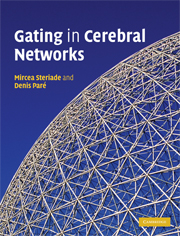Book contents
- Frontmatter
- Contents
- Preface
- Acknowledgements
- Chapter 1 Morphology and electroresponsive properties of thalamic neurons
- Chapter 2 Morphology and electroresponsive properties of neocortical cells
- Chapter 3 The amygdala
- Chapter 4 Rhinal and medial prefrontal cortices
- Chapter 5 Neuromodulation and state-dependent activities in forebrain neuronal circuits
- Chapter 6 Gating of signals in slow-wave sleep
- Chapter 7 Neuronal processes and cognitive functions in brain-active states of waking and REM sleep
- Chapter 8 Comparison of state-dependent activity patterns in the thalamocortical, hippocampal and amygdalocortical systems
- Chapter 9 Neuronal substrates of some mental disorders
- References
- Index
- Plate section
Chapter 2 - Morphology and electroresponsive properties of neocortical cells
Published online by Cambridge University Press: 18 August 2009
- Frontmatter
- Contents
- Preface
- Acknowledgements
- Chapter 1 Morphology and electroresponsive properties of thalamic neurons
- Chapter 2 Morphology and electroresponsive properties of neocortical cells
- Chapter 3 The amygdala
- Chapter 4 Rhinal and medial prefrontal cortices
- Chapter 5 Neuromodulation and state-dependent activities in forebrain neuronal circuits
- Chapter 6 Gating of signals in slow-wave sleep
- Chapter 7 Neuronal processes and cognitive functions in brain-active states of waking and REM sleep
- Chapter 8 Comparison of state-dependent activity patterns in the thalamocortical, hippocampal and amygdalocortical systems
- Chapter 9 Neuronal substrates of some mental disorders
- References
- Index
- Plate section
Summary
The prerequisite for discussing changes in responsiveness and sculpting inhibitory processes of neocortical neurons during different behavioural states (see Chapters 6 and 7) is the description of various neuronal types and their functional properties, which is the subject of this chapter.
Varieties, immunoreactivity and connectivity of neocortical neuronal classes
The mammalian neocortex is a laminated structure that contains up to 28 × 109 neurons that are connected by about 1012 synapses. The attempt to simplify the functional complexity of the neocortex started with the description of the columnar organization into modules that have a basic similarity of internal design and operation (see Mountcastle, 1997, 1998). The neocortex consists of a large population of long-axon (output) neurons that are excitatory and reciprocally connected to each other in the same and/or opposite hemisphere as well as to thalamocortical (TC) neurons, and a smaller population of local-circuit inhibitory neurons.
Besides morphological techniques that distinguish these two neuronal classes (Figures 2.1–2.3), physiological identification of output neurons is possible using antidromic and orthodromic activations (Figures 2.4 and 2.5), which determine the sources of synaptic inputs and neuronal targets (Evarts, 1964, 1965; Steriade et al., 1974a) thus leading to systematizations with a limited number of neuronal categories. These are rather difficult techniques in behaving animals; with some exceptions (Steriade et al., 2001a, b), they are rarely used nowadays. Neocortical neurons have been classified into four categories according to their intrinsic electrophysiological properties, as determined by responses to intracellular current pulses (see Section 2.3).
- Type
- Chapter
- Information
- Gating in Cerebral Networks , pp. 27 - 53Publisher: Cambridge University PressPrint publication year: 2007



